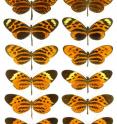Research reveals how butterflies copy their neighbors to fool birds
The mystery of how a butterfly has changed its wing patterns to mimic neighbouring species and avoid being eaten by birds has been solved by a team of European scientists. The study is published August 14, 2011 in the journal Nature. The greatest evolutionary thinkers, including Wallace, Bates and Darwin, have all wondered how butterflies that taste bad to birds have evolved the same patterns of warning colouration. Now for the first time, researchers led by the CNRS (Muséum National d'Histoire Naturelle, Paris) and the University of Exeter (UK) have shown how butterflies perform this amazing trick, known as 'Müllerian mimicry'.
Funded by the Biotechnology and Biological Sciences Research Council (BBSRC), the study focused on the Amazonian species Heliconius numata, which mimics several other butterfly species at a single site in the rainforest. One population of Heliconius numata can therefore feature many distinct wing colour patterns resembling those of other butterflies, such as the Monarch's relatives Melinaea, which are unpalatable to birds. This acts as a disguise, protecting them against predators.
The researchers located and sequenced the chromosomal region responsible for the wing patterns in H. numata. The butterfly's wing-pattern variation is controlled by a single region on a single chromosome, containing several genes which control the different elements of the pattern. Known as a 'supergene', this clustering allows genetic combinations that are favoured for their mimetic resemblance to be maintained, while preventing combinations that produce non-mimetic patterns from arising. Supergenes are responsible for a wide range of what we see in nature: from the shape of primrose flowers to the colour and pattern of snail shells.
The researchers found that three versions of the same chromosome coexist in this species, each version controlling distinct wing-pattern forms. This has resulted in butterflies that look completely different from one another, despite having the same DNA.
"We were blown away by what we found," said Dr Mathieu Joron of the Muséum National d'Histoire Naturelle, who led the research. "These butterflies are the 'transformers' of the insect world. But instead of being able to turn from a car into a robot with the flick of switch, a single genetic switch allows these insects to morph into several different mimetic forms -- it is amazing and the stuff of science fiction. Now we are starting to understand how this switch can have such a pervasive effect."
Professor Richard ffrench-Constant of the University of Exeter added: "This phenomenon has puzzled scientists for centuries -- including Darwin himself. Indeed, it was the original observations of mimicry that helped frame the concept of natural selection. Now that we have the right tools we are able to understand the reason for this amazing transformation: by changing just one gene, the butterfly is able to fool its predators by mimicking a range of different butterflies that taste bad."
This single supergene also appears important in melanism in other species, including moths. In April 2011, a team led by Liverpool University explained in the journal Science how the Peppered Moth developed its black wings in nineteenth-century Britain's sooty industrial environment.
"This supergene region not only allows insects to mimic each other, as in Heliconius, but also to mimic the soot blackened background of the industrial revolution -- it's a gene that really packs an evolutionary punch," added Professor Richard ffrench-Constant.
Chromosomal rearrangements maintain a polymorphic supergene controlling butterfly mimicry is published in Nature.
Source: University of Exeter
Other sources
- Supergene controls butterfly mimicry [video]from The Guardian - ScienceThu, 18 Aug 2011, 8:31:00 UTC
- A Supergene Paints Wings for Surviving Biological Warfrom NY Times ScienceMon, 15 Aug 2011, 22:00:27 UTC
- How butterflies copy their neighbors to fool birdsfrom Science DailySun, 14 Aug 2011, 19:30:39 UTC
- 'Supergene' is key to copycat butterfliesfrom PhysorgFri, 12 Aug 2011, 17:00:34 UTC

